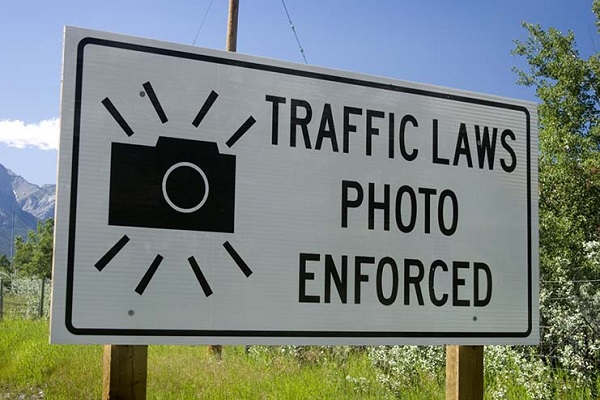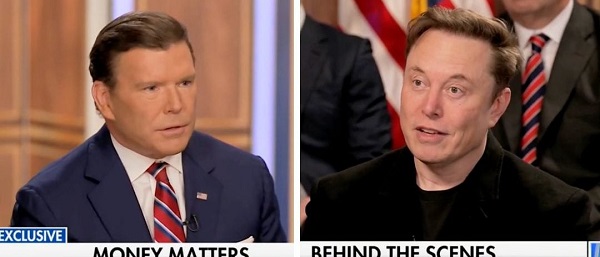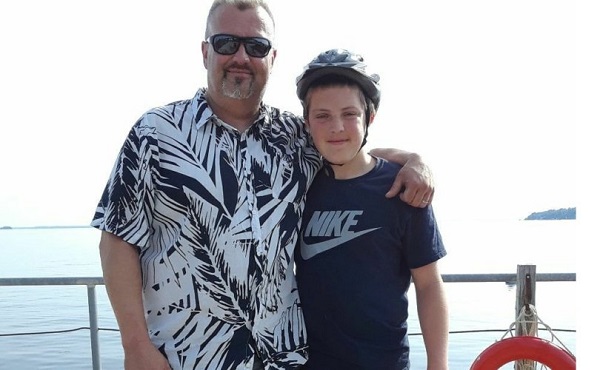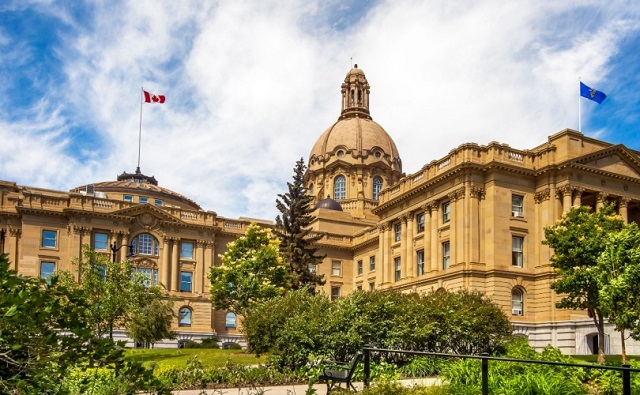Alberta
What’s on Tap? – The Vibrant Beer and Atmosphere of Railyard Brewing

Like so many of our favorite local craft breweries, the Railyard Brewing backstory began in a backyard as a project between two neighbors who simply enjoyed home brewed beer.
Opened in December 2017, Railyard Brewing’s massive taproom is located in the northeast, near the Calgary airport. Inspired by the classic graffiti art often featured on the side of train cars travelling throughout Alberta, the brewery celebrates the role of the railroad in building Alberta’s early brewing industry, with a twist. Railyard’s unique style highlights the creative within the conventional, “The craft brew industry is a dynamic industry, and we wanted to showcase that vibrant spirit by combining great craft beer with an artistic vibe.”

The first thing you’ll notice when you walk into Railyard is the 50,000 feet of black ropes dangling from the rafters surrounding the bar. Carefully arranged to represent a modern take on a traditional cathedral style ceiling, this art installment took three months to assemble and is unlike anything in the city. The industrial art gallery taproom is illuminated by string-lights draped over graffiti-covered walls and tables, where patrons can enjoy their pints and light snacks among the massive tanks where Railyard brews their beer.
With 6 core beers alongside a number of continuously rotating taps featuring their latest and greatest developments, Railyard is constantly on the move.

One of the greatest challenges in Alberta’s rapidly expanding craft brew industry, according to Aaron Wyers, Railyard Brewing Sales Manager, is keeping up with demand. “We’re always evolving, just trying to stay ahead of the trends and keep up with production,” he says. “Our Belgian Cherry DIPA can just came out last week and it sold out completely in 30 hours.”
Throughout the ups and downs of COVID-19 in Calgary, Railyard Brewing has managed to stay busy by transitioning quickly and remaining connected to the community. When the taproom shut down on March 17, the brewery responded quickly and was able to launch their online delivery service on March 19, just two days later. “The community response was massive,” says Aaron, “we had over 30 deliveries on the first day.” As local businesses weather the ongoing COVID-19 storm, Aaron encourages the public to continue supporting local. “All of the breweries in Calgary are quite close knit,” he says, “we all want to see each other succeed.”
The remainder of 2020 promises to be full of excitement for Railyard Brewing, with ongoing plans for taproom upgrades and a ton of new products. Moving forward, “We’ve got some big batch products for the entire province and lots of new stuff just for the taproom and the city of Calgary,” says Aaron, “there’s going to be something new every two or three weeks!”
For more information on Railyard Brewing, visit https://www.railyardbrewing.ca.
For more stories, visit Todayville Calgary.
Alberta
Province pumping $100 million into Collegiates and Dual-Credit hands-on learning programs

Alberta’s government is helping students discover their skills and interests today, to help them find careers for tomorrow.
If passed, Budget 2025 will provide more than $100 million over three years for school boards to grow career education programs, including funding for more collegiate and dual-credit programs across Alberta.
“We are working to set students up for success by strengthening job-focused education. This money is helping schools partner with businesses, universities and colleges to create programs that will help students hit the ground running after they graduate.”
Career education helps students gain credits towards graduation while earning hands-on experience in fields like the trades, computer programming, health care, agriculture, culinary arts and more. These career education programs support a strong economy by helping students learn the skills they need to get in-demand jobs.
Collegiate schools
Collegiate schools work with businesses, universities and colleges to offer classes that give students pathways to education and careers in the job of their choice. There are 12 collegiate schools in Alberta, offering many different types of programming for grades 7-12, including aviation, graphic design, trades and more.
If passed, Budget 2025 provides more than $21 million to school boards to help fund special classrooms like carpentry workshops, film and media rooms, science laboratories, heavy equipment simulators and aircraft hangars. Another $6 million is being invested to support the start-up costs for new collegiate schools.
Dual-credit programs
Budget 2025, if passed, also provides $4.6 million in 2025/26 to start new or improve existing dual-credit programs. In partnership with universities and colleges, dual-credit programs give students a head start on rewarding careers by allowing them to earn high-school and post-secondary credits at the same time. Of the $4.6 million, $550,000 is being provided by Alberta Seniors, Community and Social Services for new and improved dual-credit health care aide programs.
“Health care aides play a critical role in ensuring Albertans receive the continuing care services they need to maintain their health, independence and quality of life. Our investments into career pathways for health care aides will provide opportunities for young Albertans to develop the skills they need to build a rewarding career in Alberta’s continuing care workforce.”
Another $1.4 million is being invested to support students participating in off-campus career education programs through CAREERS. This non-profit connects students to jobs in high-demand fields, such as the trades, technology, health, forestry and agriculture.
“Investments in collegiate and dual-credit programming are significant for Calgary Catholic as they further strengthen our collegiate and dual-credit programming. This programming will open opportunities for our students and help them to realize their full potential.”
“Before Fusion Collegiate, I felt lost and wasn’t really sure what to do after high school. Thanks to its career-focused learning and the opportunities through Fusion and The Educational Partnership Foundation, I’m now working as a first-year apprentice plumber with Mr. Rooter. The hands-on trades training, high school credits, safety certifications, and real-world skills I picked up completely changed my life. I’m excited about where my career is headed and really thankful for the support that helped me get here.”
Budget 2025 is meeting the challenge faced by Alberta communities with continued investments in education and health, lower taxes for families and a focus on the economy.
Quick facts
- If passed, Budget 2025 invests $102.4 million over three years to provide sustainable, predictable career education funding, and to increase access to career education for Alberta students.
- This includes $8.4 million over 2026-27 and 2027-28 to raise awareness among students and families of career education programs and pathways available to Alberta students.
- Career education in Alberta includes career and technology courses, Career and Life Management (CALM), dual-credit courses, collegiate schools, apprenticeships and off-campus education programming.
- Since 2013, more than 95,000 high school students participated in at least one dual–credit course.
- In spring 2025, Alberta Education will engage with education partners on best practices to bring more career education opportunities to students.
- Since 2022, education partners and almost 5,000 Albertans have provided their feedback on career education and workforce needs.
Related information
Alberta
Photo radar to be restricted to School, Playground, and Construction Zones as Alberta ends photo radar era

Alberta’s government is fulfilling its promise to end Automated Traffic Enforcement (ATE) in select locations while enhancing safety with a new Traffic Safety Fund.
For years, Alberta has had the most ATE sites of any jurisdiction in Canada with many serving as a “cash cow,” generating millions of dollars in revenue with no clear evidence they were improving traffic safety. Now, following thorough consultation and review of existing ATE sites, Alberta’s government is making significant changes to restore public trust in the use of photo radar.
Effective April 1, the updated ATE Technology Guideline will prohibit photo radar on numbered provincial highways and connectors, restricting it only to school, playground and construction zones. Intersection safety devices in Alberta will also be limited to red light enforcement only, ending the “speed-on-green” ticketing function.
“We have officially killed the photo radar cash cow and the revenue-generating “fishing holes” that made Alberta the biggest user of photo radar in Canada. The updated guideline will ensure that photo radar is used for safety only. The new provincial traffic safety fund will support municipalities in physical improvements at key intersections, helping to reduce traffic risks and enhance safe roads.”
Alberta’s government has also created a new $13-million Traffic Safety Fund for municipalities to upgrade local roads and intersections that pose demonstrated safety risks. Details will be made available on how to apply for the Traffic Safety Fund, once the application process has been finalized.
“This shift ensures that photo radar is used where it matters most – near schools, playgrounds and construction zones. Traffic enforcement should be about protecting people, not generating revenue. The new Traffic Safety Fund gives municipalities the tools to make targeted improvements to roads and intersections with real safety concerns. Keeping Edmontonians safe on our streets must always remain the priority.”
“Shifting photo radar to playgrounds and construction zones enhances safety where it matters most – protecting our children and workers on Calgary’s roads. I’m proud to back this important step toward safer communities.”
“The Traffic Safety Fund is a welcome addition to the overall funding available to municipalities. The Rural Municipalities of Alberta support a dynamic approach to managing traffic safety.”
Municipalities are encouraged to use traffic calming measures instead of photo radar but may request provincial approval for an exemption to the photo radar ban in high-collision locations. To do so, municipalities must submit a business case detailing high-collision frequency and severity at the site, relative to similar locations, and demonstrate how other safety measures are not possible or will be ineffective. To be approved for an exemption, they must also commit to audit the exempted site every two years to assess the effectiveness of photo radar in reducing collisions at that location.
The updated ATE Technology Guideline also includes parameters around equipment testing and maintenance, data collection and reporting requirements, traffic safety plans, signage and public communication of photo radar locations.
Quick facts
- On April 1, the new ATE 2025 Technology Guideline comes into force.
- The newly created Traffic Safety Fund will provide $13 million over three years to help municipalities re-engineer intersections to reduce collisions:
- $1 million in 2025-26
- $2 million in 2026-27
- $10 million in 2027-28
- Alberta first introduced photo radar in 1987.
Related information
-

 Business17 hours ago
Business17 hours agoFeds Spent Roughly $1 Billion To Conduct Survey That Could’ve Been Done For $10,000, Musk Says
-

 COVID-192 days ago
COVID-192 days ago17-year-old died after taking COVID shot, but Ontario judge denies his family’s liability claim
-

 Business2 days ago
Business2 days agoWhile “Team Canada” attacks Trump for election points, Premier Danielle Smith advocates for future trade relations
-

 2025 Federal Election2 days ago
2025 Federal Election2 days agoPoilievre refuses to bash Trump via trick question, says it’s possible to work with him and be ‘firm’
-

 2025 Federal Election1 day ago
2025 Federal Election1 day agoChinese Gangs Dominate Canada: Why Will Voters Give Liberals Another Term?
-

 Health7 hours ago
Health7 hours agoRFK Jr. Drops Stunning Vaccine Announcement
-

 2025 Federal Election1 day ago
2025 Federal Election1 day agoFool Me Once: The Cost of Carney–Trudeau Tax Games
-

 Energy24 hours ago
Energy24 hours agoEnergy, climate, and economics — A smarter path for Canada




